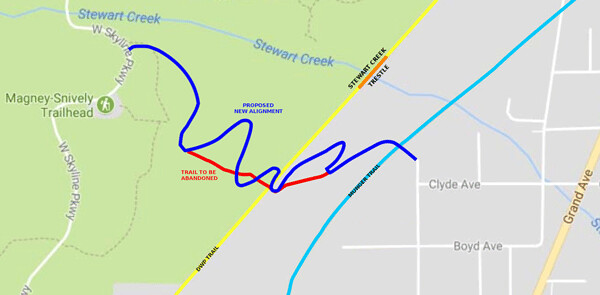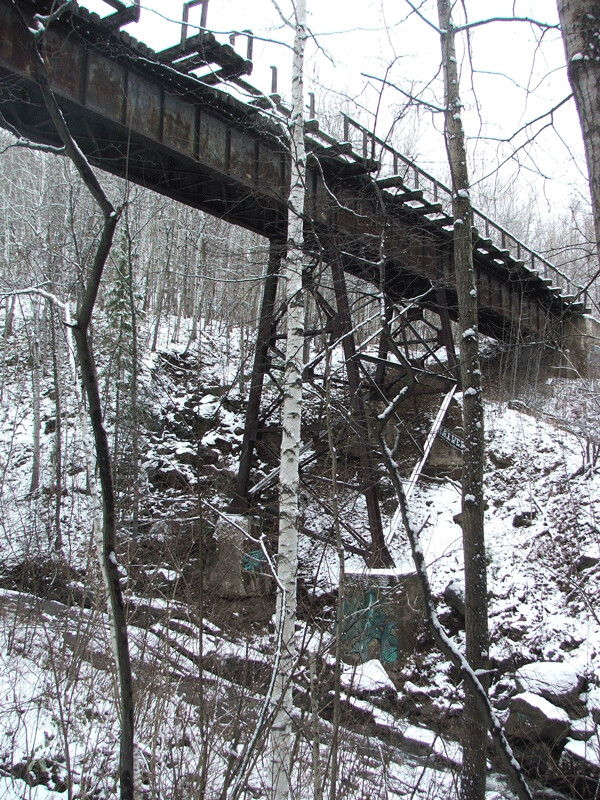News & Articles
Browse all content by date.

Among the many recreation projects underway in the St. Louis River corridor is the Clyde Connector trail. The Clyde Connector, which begins at the end of 95th Avenue West off of Clyde Avenue in Smithville, is a steep path—more than a hiking trail, less than a road—that connects the Munger Trail at the bottom of the hill with Skyline Parkway at the top. Historically, snowmobilers and others (equestrians, skiers, dog walkers) used the Clyde Connector as a valuable link between the top and bottom of the hill. In 2012, however, Duluth’s Great Flood largely destroyed the trail, rendering it impassable to all but the most determined scramblers. The Clyde Connector has been officially closed ever since.
It is now being repaired and reimagined. On Sept. 11, 2017, the city council approved a contract with Stack Brothers Construction to rebuild the Clyde Connector. The cost of the project is $309,124. Of this amount, $150,000 is being covered by a federal grant and the rest by the city’s half-and-half tourism tax. The half-and-half tax, which refers to a half-percent tax on restaurant meals and a half-percent tax on hotel stays in the city, raises money for recreation projects in the St. Louis River corridor.

Much of the existing blown-out Clyde Connector will be abandoned, and a new route utilizing switchbacks will take its place. One reason the old trail failed was because it ran more or less straight up the hill, with no erosion control—when the flood came, water shot straight down the trail and gullied it out. The new switchbacks will be designed in such a way as to (hopefully) shed water before it does too much damage. The switchbacks will also help to reduce the grade of the trail—though not enough to meet federal accessibility guidelines.
“It’s too steep,” city project coordinator Jim Shoberg told a group of citizens at an informational meeting on September 9. “There’s no amount of switchbacks that we could put in this trail to [achieve accessible grades for wheelchairs]. Well, we could, but it would use the whole hillside, and we’re not going to do that.”
For the past several weeks, Stack Brothers has been working from both the top and the bottom of the hill, graveling and grading existing trail and constructing new trail. One long new switchback on the upper part of the hill is complete, though at this point it dead-ends in the woods. According to Shoberg, Stack Brothers had originally hoped to finish the project this fall, but the early snows put a stop to that. Workers are now wrapping up work for the season.
The Clyde Connector originally passed under a small timber trestle on the abandoned Duluth Winnipeg and Pacific (DWP) rail line. Part of the project involves removing this trestle, filling the gap with earth, and establishing a new trail crossing over the railroad grade. “We like eliminating the trestle, because that’s one less piece of expensive infrastructure [to maintain],” said Shoberg. Most of this work is already done: the trestle has been removed and the fill placed. When work resumes in the spring, the new switchbacks will be built to meet the new grade crossing.




Stewart Creek trestle
Several hundred feet east of the Clyde Connector along the DWP stands the Stewart Creek trestle, which may qualify as one of Duluth’s coolest places. With its rotting boards, yawning holes and the occasional loose railroad tie rolling queasily under one’s feet over a long drop into the abyss, the Stewart Creek trestle is always an adventure to cross. It has not been maintained since that section of the DWP was abandoned in the early 1980s.
On Sept. 11, the city council approved a $450,322 contract with George Bougalis and Sons to re-deck the trestle, install railings to prevent people from plummeting to their deaths, and reinforce the trestle’s 110-year-old concrete footings, which have been compromised by time and floods. The half-and-half tax will pay for $250,322 of the project and the rest will be covered by a $200,000 grant from the state.
Currently, only hikers and bicyclists are officially allowed on the DWP. As such, the Stewart Creek trestle project calls for installing gates at either end of the trestle to prevent unauthorized snowmobile and ATV use. The issue of where motorized off-road vehicles should be allowed to operate in the city has been a contentious conversation for a long time, but little has been resolved. Snowmobilers would very much like to use the Stewart Creek trestle, as this would give them a straight shot to Spirit Mountain’s lower chalet, rather than forcing them to climb the Clyde Connector and go all the way around. But many neighbors in the area oppose the use of snowmobiles on the DWP, citing noise and privacy concerns. As the city continues to repair rundown trails, this conversation will undoubtedly heat up.
According to Shoberg, Bougalis and Sons wants to start doing concrete work on the trestle footings this winter if the weather cooperates. They also hope begin work on the new deck in January. Workers will access the DWP via Gogebic Street, so residents of that neighborhood can expect to see trucks and equipment moving in and out.
All work on both the Stewart Creek trestle and the Clyde Connector is scheduled to be completed no later than June 30, 2018.
The Scaia’s the limit
It’s not a great time to be a Scaia in Chisholm, Minnesota. On October 5, I wrote about Chisholm Mayor Todd Scaia threatening to call the police on me for asking him about the mysterious resignation of former City Administrator Katie Bobich. The same week, Todd’s older brother, City Councilor Kevin Scaia, found himself in the news as well, charged with sexually groping a woman in a Chisholm bar. The gross misdemeanor charge carries a maximum penalty of 1 year in jail and/or a $3,000 fine.
According to the criminal complaint, when investigators confronted Councilor Scaia with the victim’s accusations, he “began to speak poorly” of her—but then, after finding out the incident had been recorded by the bar’s security camera, he declared that he was a “political target” who was probably being set up by his enemies. “I didn’t mean anything by it,” the complaint states him saying. “It’s just something I did.”
This is not the first time Kevin Scaia has been in trouble with the law. Late one night in November of 2013, after consuming a fair amount of alcohol, Scaia was driving along a highway during a snowstorm. As he came over a rise, he struck another vehicle which was sitting crosswise in the middle of the road. His own vehicle ended up on its side in the ditch. Investigators determined that the driver of the other vehicle, John Adamic, had been involved in an accident prior to Scaia’s accident. They further determined that Mr. Adamic was already deceased when Scaia struck his vehicle.
When police conducted a field sobriety test on Scaia, he failed it. He refused to take a Breathalyzer test and refused to consent to a blood draw. When officers forced a blood draw some time later, Scaia was found to have a blood-alcohol content of 0.05. He was charged with careless driving, driving while impaired, and refusal to take a sobriety test. In the end, however, the two most serious charges were dropped and Scaia was only convicted of careless driving, for which he was fined $200—a slap on the wrist if ever there was one.
Five months later, Scaia filed a civil suit against the estate of John Adamic, seeking $50,000 in damages for a shoulder injury he said he suffered in the accident. After listening to the facts, a jury concluded that Scaia’s injuries were in large part due to his own negligence and declined to award him anything.
City council criticism
Since the news reports about his latest transgression appeared, Kevin Scaia has disappeared from public life. He doesn’t answer his phone or return messages left by reporters. He has attended no more city council meetings. So far he’s missed two. Under state statute, if an elected official misses meetings for 90 days, they can be removed from their position.
At the October 25 city council meeting, two citizens showed up at Chisholm City Hall to address the council about the Scaia charges and the Bobich resignation. One speaker, Andy Enrico, said that he was “absolutely embarrassed” by the actions and “lack of transparency” of the city’s leadership. “I see one embarrassment after another. One after another….We’re not getting any answers. I want some kind of answers. I’d love to have some kind of answers.” Mayor Scaia, at one point, tried to invoke the five-minute-per-person rule, but Enrico rolled right over him and spoke for almost 12 minutes, engaging in a spirited back-and-forth with councilors, the city attorney and others. Clearly, the news that Americans no longer engaged in robust civic dialogue hadn’t reached Mr. Enrico. “I will be here every month, and I expect much, much more transparency in this council going forward,” he declared.
The second speaker, Blanche Pallin-Mlakar, called for the resignation of Councilor Scaia, saying that his personal scandals would “distract him from his ability to effectively represent and serve the citizens.” Pallin-Mlakar also decried the negative portrayal of Chisholm in the press. “With the recent successes in and around our community, such as our pocket parks, our broadband initiatives, our Slide the Citys, our beautifications, our upgrading our walking trails, our bocce ball courts, the schools, the gardens, and all the collaboration it took to make these amenities available to us, are all overshadowed by all the negativity of the alleged actions of some of our leaders.”
Later in the meeting, the city council passed a resolution asking Kevin Scaia to resign his seat, saying that his personal scandals were distracting from city business and that to allow his service to continue would “cast a cloud on the perceived collective judgment of this council.” Four councilors—Tracy Campbell, Marty Halverson, Mary Jo Rahja, and Jim Varda—voted in favor of the resolution. Mayor Todd Scaia abstained from voting, “for obvious reasons.”
Regular readers will know that I am no fan of Kevin Scaia. I have documented instances where he has used his position to bully others. Nevertheless, I find it troubling to see a city council attempting to remove one of its members merely for being a distraction. The presumption of innocence should apply to all persons until convicted. If “distraction” is a criteria for removal, nobody’s safe.
Luckily, the council’s resolution is non-binding. It’s intended to symbolically register disapproval rather than actually remove Scaia from office. Kevin Scaia could resign from the council, or he could decide not to, and he would be within his rights either way.
Currently, Scaia is free on $6,000 bail, with instructions not to drink alcohol or visit any bars. His next court appearance is scheduled for November 16 in Hibbing.
| Tweet |

